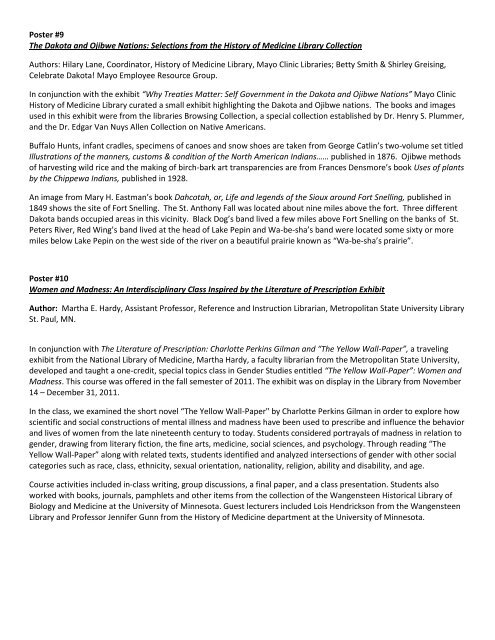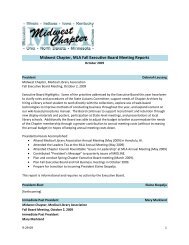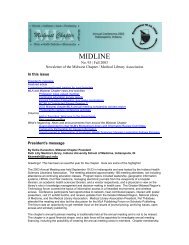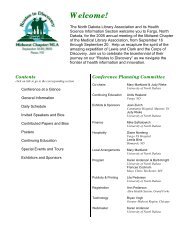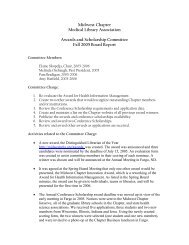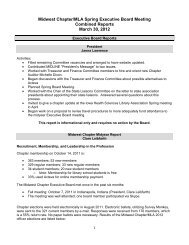full conference program - Midwest Chapter MLA
full conference program - Midwest Chapter MLA
full conference program - Midwest Chapter MLA
Create successful ePaper yourself
Turn your PDF publications into a flip-book with our unique Google optimized e-Paper software.
Poster #9<br />
The Dakota and Ojibwe Nations: Selections from the History of Medicine Library Collection<br />
Authors: Hilary Lane, Coordinator, History of Medicine Library, Mayo Clinic Libraries; Betty Smith & Shirley Greising,<br />
Celebrate Dakota! Mayo Employee Resource Group.<br />
In conjunction with the exhibit “Why Treaties Matter: Self Government in the Dakota and Ojibwe Nations” Mayo Clinic<br />
History of Medicine Library curated a small exhibit highlighting the Dakota and Ojibwe nations. The books and images<br />
used in this exhibit were from the libraries Browsing Collection, a special collection established by Dr. Henry S. Plummer,<br />
and the Dr. Edgar Van Nuys Allen Collection on Native Americans.<br />
Buffalo Hunts, infant cradles, specimens of canoes and snow shoes are taken from George Catlin’s two-volume set titled<br />
Illustrations of the manners, customs & condition of the North American Indians…… published in 1876. Ojibwe methods<br />
of harvesting wild rice and the making of birch-bark art transparencies are from Frances Densmore’s book Uses of plants<br />
by the Chippewa Indians, published in 1928.<br />
An image from Mary H. Eastman’s book Dahcotah, or, Life and legends of the Sioux around Fort Snelling, published in<br />
1849 shows the site of Fort Snelling. The St. Anthony Fall was located about nine miles above the fort. Three different<br />
Dakota bands occupied areas in this vicinity. Black Dog’s band lived a few miles above Fort Snelling on the banks of St.<br />
Peters River, Red Wing’s band lived at the head of Lake Pepin and Wa-be-sha’s band were located some sixty or more<br />
miles below Lake Pepin on the west side of the river on a beautiful prairie known as “Wa-be-sha’s prairie”.<br />
Poster #10<br />
Women and Madness: An Interdisciplinary Class Inspired by the Literature of Prescription Exhibit<br />
Author: Martha E. Hardy, Assistant Professor, Reference and Instruction Librarian, Metropolitan State University Library<br />
St. Paul, MN.<br />
In conjunction with The Literature of Prescription: Charlotte Perkins Gilman and “The Yellow Wall-Paper”, a traveling<br />
exhibit from the National Library of Medicine, Martha Hardy, a faculty librarian from the Metropolitan State University,<br />
developed and taught a one-credit, special topics class in Gender Studies entitled “The Yellow Wall-Paper”: Women and<br />
Madness. This course was offered in the fall semester of 2011. The exhibit was on display in the Library from November<br />
14 – December 31, 2011.<br />
In the class, we examined the short novel “The Yellow Wall-Paper" by Charlotte Perkins Gilman in order to explore how<br />
scientific and social constructions of mental illness and madness have been used to prescribe and influence the behavior<br />
and lives of women from the late nineteenth century to today. Students considered portrayals of madness in relation to<br />
gender, drawing from literary fiction, the fine arts, medicine, social sciences, and psychology. Through reading “The<br />
Yellow Wall-Paper” along with related texts, students identified and analyzed intersections of gender with other social<br />
categories such as race, class, ethnicity, sexual orientation, nationality, religion, ability and disability, and age.<br />
Course activities included in-class writing, group discussions, a final paper, and a class presentation. Students also<br />
worked with books, journals, pamphlets and other items from the collection of the Wangensteen Historical Library of<br />
Biology and Medicine at the University of Minnesota. Guest lecturers included Lois Hendrickson from the Wangensteen<br />
Library and Professor Jennifer Gunn from the History of Medicine department at the University of Minnesota.


